How to Start a Food Forest
for ease, beauty, sustainability, nutrition, sovereignty, connection, and pleasure
The food forest plans at the new Living Heart Sanctuary are underway! It felt important to focus first on the inner sanctuary of the home (‘zone 1,’ in permaculture-speak); now, four-plus months later, attention has organically shifted toward the outdoor food-scape around the home (zone 2). Summer is typically a rainier season here in southwest Florida, and it’s smart to get new trees planted in time for young plants to be watered in well by the summer rains.
Design:
Three years ago, I started a food forest at my previous Florida home. It had just begun producing, when life brought me to a different Florida home. That felt like a hard loss, but I learned a lot about growing fruit in this subtropical region, so I have a nice head-start on planning a new fruit-scape here. Fortunately, things grow pretty quickly in southern Florida. Nearly 5 months of living in the new home, watching growth and blooming patterns of the existing plants, sun and shade patterns throughout the day, as well as human foot-traffic habits of myself and many visitors, has informed my design ideas. And, I relate to a project like this as a flexible work-in-progress, forever. This attitude is realistic, and helps me to just get started!
I have .28 of an acre to work with, minus the footprints of house, shed, and 2 driveways. So it’s a relatively small space, and the first phase of installation will focus primarily on one main open sunny area which is a natural gathering space for friends, guests and retreat clients. This focus will simplify installation and irrigation in the beginning, and create a magical concentrated fruit-scape relatively quickly. It’s a big bonus to integrate the main gathering space and pathways right into the fruit-forest gardens, for maximum human attention and interaction.
Preparation:
This week, it was exciting to get a new well installed (15 feet depth seems to be the magic number around here), and to receive two huge mulch dumpings to get things rolling. I collected lots of large thick cardboard boxes, which I prepped by opening flat and removing all tape and staples. Each time a tree or community of trees and shrubs is planted, a layer of cardboard will be placed around it, sprayed with water to moisten, then covered with at least a foot-high layer of mulch. This will help eliminate competing lawn-grasses and unwanted weeds, retain moisture for the new plantings, and gradually enrich the soil as it breaks down.
The mulch is also used as a cover material in our 3-bin compost system. In a few months, we will have our first finished compost to add to the food forest. These initial mulch piles are derived mostly from palm trees, which makes a relatively soft and grassy mulch. It will break-down faster than hard-wood mulch, which makes it perfect for building richer soil quickly, initially. (It was the luck-of-the-draw, anyway, because I get cheap mulch by having landscapers/tree-workers in the area bring whatever they have from their last job while it’s still in their truck.)
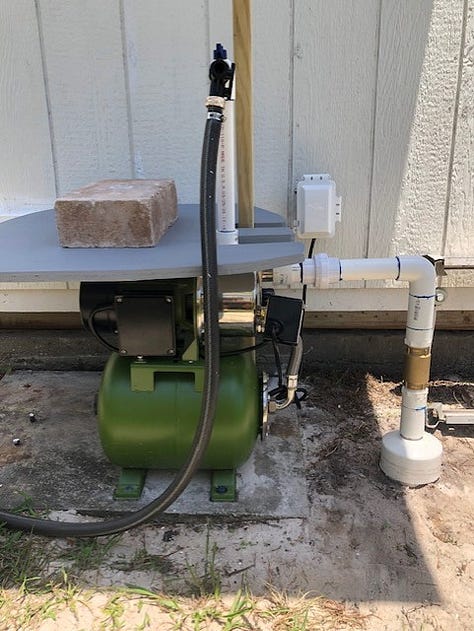
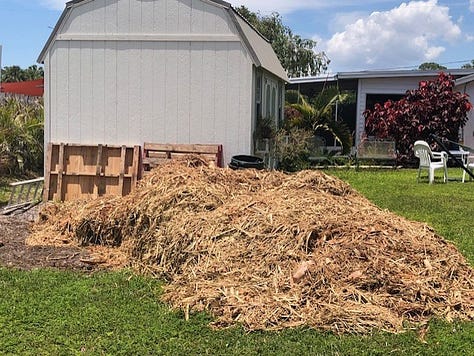

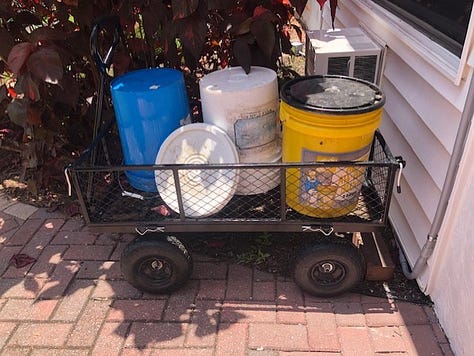
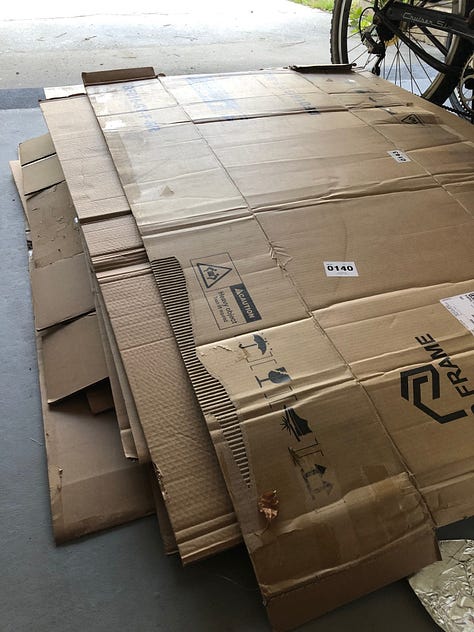
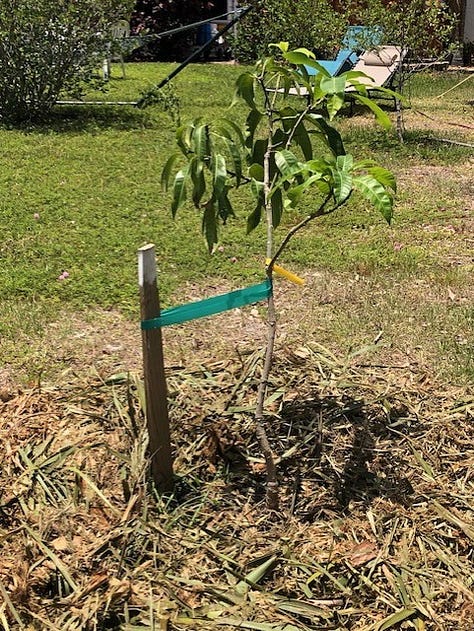
Plant selection:
I will prioritize plants that bear edible fruit that I love to eat. Other priority factors are ever-bearing staples (such as bananas and papayas), and delicious fruits that are hard to find or very pricey in stores, such as jackfruit, black sapote, ice cream bean, peanut butter fruit, and canistel (egg-fruit). I love to have cherries and berries frequently available for picking. The best ones to grow here are barbados cherries, surinam cherries, strawberries and mulberries. My list also includes avocado, lemon, longon, lychee, sugar apple, fig, passion fruit, dragon fruit, grapes, and perhaps a dwarf coconut tree. Pineapples are easy to grow by planting the tops of ones I eat from the store, and the fun fuchsia-colored beauty-berries grow easily from friends’ cuttings.
Other useful plants to add here will be Mexican fire-bush (for butterflies), Mexican sun-flower bush ( beautiful and great for quick privacy screening which is easily chop ‘n drop removable when the fruit trees have grown bigger, also loved by birds), rosea hibiscus, native spinach varieties (such as longevity), ginger, some herbs (butterflies - or caterpillars - like parsley and carrot-tops!), and native ground-covers such as sweet potato. Already growing here are key lime and wild lime (a butterfly tree), some bananas and pineapples, coco-plum, aloe, and lots of wonderful flowers, vines and shrubs favored by butterflies and caterpillars, and an occasional hummingbird.
I don’t plan to focus so much on lettuces, cucumbers, tomatoes or vegetables, because they are not as easy to grow here, and organic varieties are easy to buy locally from farmers I know and trust. I will experiment at some point with tucking a few greens and tomatoes into existing flower beds or pots. In southern Florida, winter/spring is the season for them, not summer.
I am primarily interested in gradually creating a low-maintenance, beautiful, food-productive and interactive landscape that mimics a food forest in the sense of incorporating layers (over-stories, under-stories, vertical vines, ground-covers, tubers), and encouraging attractive habitats for native birds, animals, turtles, and friendly insects, snakes, and reptiles. The forest layers work together synergistically to gently shade, protect and mulch each other, naturally. Less work for me! And happier for the plants and animals. I also use a no-dig/no-till method, which is also less work for me, but more importantly causes minimal disruption or destruction to the communities of microorganisms in the soil.
I will need to source help with the digging and mulching work involved in the installation phase. I know a guy in town who gives hard physical labor for $25/hour, and perhaps I will also appeal to the folks in our monthly fruit-luck group and arrange a ‘work-party.’ And if I pace myself, on my own I can steadily plant or mulch a bit at a time over the next several months. Bit by bit, this little food forest on an average neighborhood lot will come into focus. I aim to maintain a healthy perspective, stay inspired, keep the process fun and satisfying, and allow plenty of time for this dream to ripen to fruition.
Some friends in the neighborhood have created a free monthly live forum in their downtown plant shop, for folks growing food in their yards to share experiences with each other. I look forward to sharing and learning!


Terrific, Ellen, that you are planting a food forest - one of the most earth-friendly and health-friendly things a human can do - and thanks for encouraging us all as well! The nature spirits will be happy also! Wishing you all the best with it!